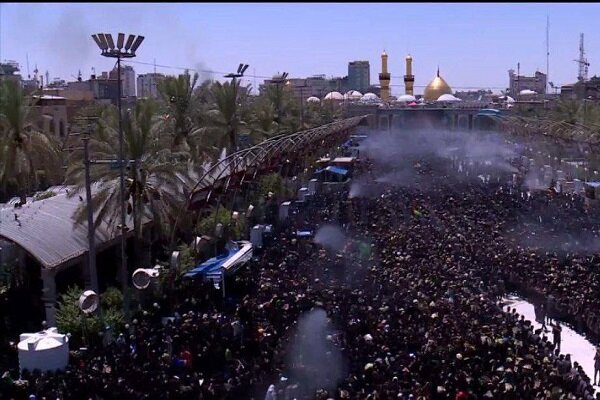AhlulBayt News Agency: The women of the Bani Asad tribe attended the shrine of the Martyrs of Salar. According to this tradition, women appear in this ceremony with wicker baskets, which is a symbol of the buriya in which the holy body of Imam Hussain (a.s.) and his companions were shrouded.
According to historical reports, Bani Asad tribe buried the pure bodies of the martyrs three days after the martyrdom of Imam Hussain (AS) while crossing the desert of Karbala.
The bodies of the martyrs of Karbala were buried after how many days and by whom?
According to historical and Muqatil books, the burial of the holy body of Imam Hussein (peace be upon him) and the holy bodies of the martyrs of Karbala at the end of the 12th day (13th night) of Muharram by a group of men from the Bani Asad tribe who camped and lived near Karbala, has been done.
Bani Asad, the name of one of the Arab tribes, is one of the descendants of Asad bin Khuzimah bin Madraqa, this tribe had the privilege and honor of burying the pure body of Hazrat Seyyed al-Shaheda and his followers. They had Hazrat after the incident of Karbala in 61 AH.
Many companions, scholars, poets and leaders of the Imamiyyah came from this tribe. Some of the wives of the Holy Prophet (PBUH) were also from this tribe. This tribe went to Iraq from Hejaz region in 19 AH and settled in Kufa and Ghazaria from Karbala areas. They are considered one of the Arab warrior tribes.
During the construction of Kufa, this tribe allocated a special neighborhood to the south of Kufa Mosque. In the year 36 Hijri, in the Battle of Jamal, they pledged allegiance to Ali (AS) and fought alongside him. In the Ashura uprising in the year 61, they were divided into three categories: those who support the Prophet, those who oppose him, and those who are neutral. Habib bin Mazaher, Anas bin Harith, Muslim bin Ausjah, Qays bin Mashar, Mozat bin Thamama and Amr bin Khalid Siddawi were among the leaders who were in favor, and Harmala bin Kahl Asadi, the murderer of the infant, was among the leaders against.
A group from the third category (neutrals) after the martyrdom of Imam Hossein (AS), their women crossed the battlefield and saw the corpses and under They were influenced and went to their land and informed the men to bury the bodies. First, the women went towards Karbala holding shovels and picks. After some time, the conscience of the men of Bani Asad woke up and they came to their senses and started burying the dead bodies of the Imam and his companions after the women who had left. The sacrifice of the members of this tribe made them famous, and since then, Shiites respect and love the Bani Asad tribe.
/129
According to historical reports, Bani Asad tribe buried the pure bodies of the martyrs three days after the martyrdom of Imam Hussain (AS) while crossing the desert of Karbala.
The bodies of the martyrs of Karbala were buried after how many days and by whom?
According to historical and Muqatil books, the burial of the holy body of Imam Hussein (peace be upon him) and the holy bodies of the martyrs of Karbala at the end of the 12th day (13th night) of Muharram by a group of men from the Bani Asad tribe who camped and lived near Karbala, has been done.
Bani Asad, the name of one of the Arab tribes, is one of the descendants of Asad bin Khuzimah bin Madraqa, this tribe had the privilege and honor of burying the pure body of Hazrat Seyyed al-Shaheda and his followers. They had Hazrat after the incident of Karbala in 61 AH.
Many companions, scholars, poets and leaders of the Imamiyyah came from this tribe. Some of the wives of the Holy Prophet (PBUH) were also from this tribe. This tribe went to Iraq from Hejaz region in 19 AH and settled in Kufa and Ghazaria from Karbala areas. They are considered one of the Arab warrior tribes.
During the construction of Kufa, this tribe allocated a special neighborhood to the south of Kufa Mosque. In the year 36 Hijri, in the Battle of Jamal, they pledged allegiance to Ali (AS) and fought alongside him. In the Ashura uprising in the year 61, they were divided into three categories: those who support the Prophet, those who oppose him, and those who are neutral. Habib bin Mazaher, Anas bin Harith, Muslim bin Ausjah, Qays bin Mashar, Mozat bin Thamama and Amr bin Khalid Siddawi were among the leaders who were in favor, and Harmala bin Kahl Asadi, the murderer of the infant, was among the leaders against.
A group from the third category (neutrals) after the martyrdom of Imam Hossein (AS), their women crossed the battlefield and saw the corpses and under They were influenced and went to their land and informed the men to bury the bodies. First, the women went towards Karbala holding shovels and picks. After some time, the conscience of the men of Bani Asad woke up and they came to their senses and started burying the dead bodies of the Imam and his companions after the women who had left. The sacrifice of the members of this tribe made them famous, and since then, Shiites respect and love the Bani Asad tribe.
/129

